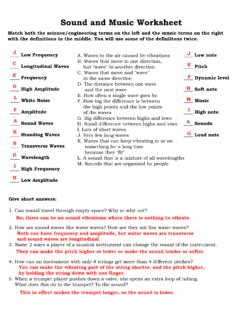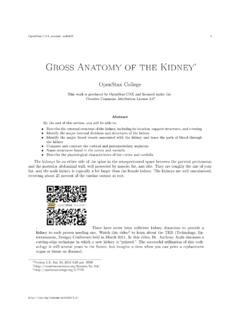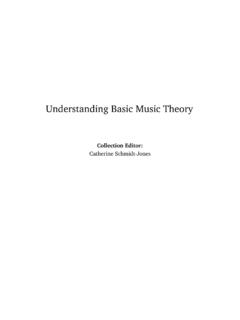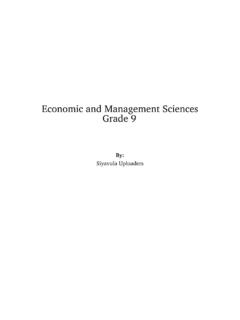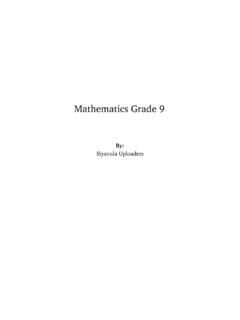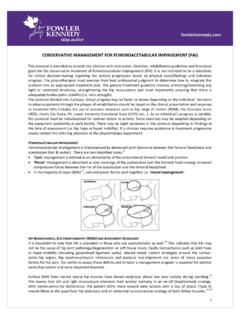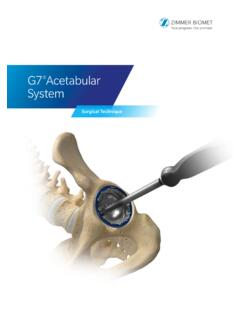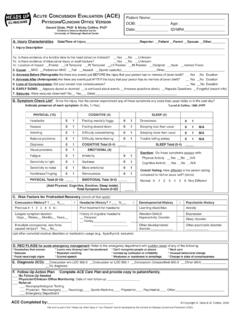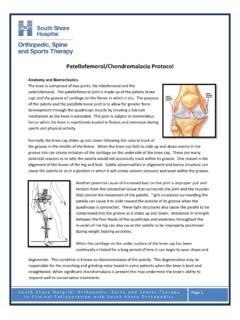Transcription of Fundamentals of Biomechanics - CNX
1 BiomechanicsPage 1 of 22 Bill SellersFundamentals of BiomechanicsBill Sellers: notes at: ~wis/lectures/These lectures are intended to give you the basic mechanical theory that you will need tounderstand the rest of the course. It is necessarily technical but hopefully not too difficult tofollow. It will be revision for anyone with A-level maths or physics, and much of it will havebeen covered in GCSE maths and physics too. You will be assessed on this part of the courseby solving a number of problems and there are plenty of examples to work through to giveyou practice. This part of the course will concentrate on rigid-body mechanics since this isthe commonest and most generally useful ) What is Biomechanics ?As you can probably guess Biomechanics is the application of mechanics to is a branch of applied mathematics that deals with movement and tendency tomovement; it is also the science of machines.
2 In practice there is no difference betweenbiomechanics and mechanics except what is studied. Certainly in terms of underlying theorythere is no difference whatsoever. However common usage of the term varies slightly fromthis rigid definition. A biomechanist is often interested in the physiology underlyingmovement (muscle physiology, nervous control, for example) and also the biological r le ofthe movement (foraging, ranging, predator avoidance). Additionally certain aspects ofmechanics are rarely of interest such as quantum mechanics and ) Brief history of biomechanicsFormal mechanics in the modern sense dates back to Sir Isaac Newton in the 17th century butstudying objects in motion dates back to the Ancient Greeks. Biology has always had a stronginfluence on design:If one way be better than another, that you may be sure is Nature's , fourth century ingenuity may make various inventions, but it will never devise any inventions morebeautiful, nor more simple, nor more to the purpose than Nature does; because in herinventions nothing is wanting and nothing is da Vinci, fifteenth centurySources of hydraulic contrivances and of mechanical movements are endless in nature.
3 And ifmachinists would but study in her school, she would lead them to the adoption of the bestprinciples, and the most suitable modifications of them in every possible Ewbank, mid-nineteenth century4 BiomechanicsPage 2 of 22 Bill SellersOne handbook that has not yet gone out of style, and predictably never will, is the handbookof nature. Here, in the totality of biological and bio-chemical systems, the problems mankindfaces have already been met and solved, and through analogues, met and solved Papanek, contemporaryb) Relevance to ergonomicsA common problem in ergonomics is the analysis of a human performing a given task and thedesign of appropriate tools. One part of this analysis is to understand the mechanics of theperson and any interactions with his or her surroundings essentially a biomechanicalproblem.
4 Thus Biomechanics is a key skill for the ) Fundamental conceptsa) DimensionsSince Biomechanics is a quantitative discipline there are a set of units that must be used whenexpressing values. In fact there are only three basic units that are used and all other units thatwe encounter can be considered as composites of the basic three. These composite units areoften given names to make them less cumbersome to use but remembering how they breakdown into the basic units can be a useful aid to remembering the underlying ) LengthLength (or distance) is obviously a key measurement in describing movement. It shouldalways be converted into metres before doing any biomechanical calculations to avoidproblems later on. It is generally measured with various forms of calibrated rulers and tapesalthough it can by more complex methods such as the timing of fixed velocity waves (soundand electromagnetic).
5 The metre is the length of the path travelled by light in vacuum during a time interval of1/299 792 458 of a ) TimeThis is another key measurement that allows us to quantify changes of position. Velocity andacceleration are distances differentiated with respect to time. It should always be convertedinto seconds for calculation. It is generally measured by counting oscillations: springs,pendulums, or electronic oscillators such as second is the duration of 9 192 631 770 periods of the radiation corresponding to thetransition between the two hyperfine levels of the ground state of the caesium 133 3 of 22 Bill Sellersiii) MassThis allows us to measure how much of a material we are dealing with. Again this is essentialfor mechanics and allows us to quantify inertia (inertia and mass are basically synonyms).
6 Itis usually measured by measuring the force due to gravity that is exerted on the mass. Thereis currently no way of defining a kilogram except with reference to the world's standardkilogram kept by the International Bureau of Weights and Measures (BIPM) in kilogram is equal to the mass of the international prototype of the ) NewtonNewton published his Principia in 1686 which lays down the fundamental rules ofmechanics. In this he published his famous three laws of motion that can be used to solvemost biomechanical problems. It also contains his law of universal gravity which is ) Newton s First Law of MotionEvery body continues in its state of rest or of uniform motion in a straight line unless it iscompelled to change that state by forces impressed upon this means is that a stationary body will stay stationary if there are no net forces actingon it: no surprises there.
7 But it also says that a body moving with constant velocity willcontinue to move at a constant velocity if there are no net forces acting on it which needs abit more thought. We all know that you have to keep pushing something to keep it what is happening in this case is that you need to keep applying a force that is equalto and in the opposite direction of the force produced by friction (more on friction later). Ifyou have an object moving at uniform velocity on ice for example it will keep going for avery long time because the friction is very ) Newton s Second Law of MotionThe change of motion of an object is proportional to the force impressed and is made in thedirection of the straight line in which the force is is actually the definition of what a force is: something that causes objects to can be stated mathematically as:Equation :6 BiomechanicsPage 4 of 22 Bill SellersFis the net external force (N)mis the mass of the object (kg)ais the acceleration of the object (ms-2)This means that if you know any two of force, mass and acceleration you can calculate themissing value.
8 Note that force and acceleration are vector quantities: this means that theirdirection is important not just their magnitude. The second law also explains the first law. Ifno net force is acting on a mass then there is no change of velocity (acceleration). Thus astationary object (velocity zero) will stay stationary, and an object with a uniform velocitywill continue with that same uniform ) Newton s Third Law of MotionTo every action there is always opposed an equal reaction: or the mutual actions of twobodies upon each other are always equal and directed to contrary this means is that whenever a force is applied to an object then force acts both ways. IfI push a wall with a force of 100N then the wall pushes back at me with exactly the sameforce. Again this is often counter intuitive because often only one of the objects appears tomove but once again this is generally because of friction.
9 If you stand in a boat and pushagainst a wall you will accelerate backwards. If you push another boat, both boats will moveaway from each other. The earth does move slightly when you push against it but because itis so much more massive than you are you do not see the movement!iv) Newton s Law of Universal GravitationThis is the law that is supposed to relate to the apple falling incident. Newton stated thatevery object attracts every other object with a force inversely proportional to the square of thedistance between the two objects and proportional to the mass of each of the this can be stated as:Equation 2. =221rmmGFWhere:Fis the gravitational force acting between the objects (N)Gis universal constant of gravitation (m3s-2kg-1)1mis the mass of object 1 (kg)2mis the mass of object 2 (kg)ris the distance between the objects (m)G is very small ( 10-11 m3s-2kg-1) so in practice unless one of the objects has a veryhigh mass we can ignore this force.
10 The only important large mass for Biomechanics is the7 BiomechanicsPage 5 of 22 Bill Sellersmass of the earth. In this case the distance is also fixed since the radius of the earth is verymuch larger than any normal changes of altitude. This means that we can create a newconstant for use on the surface of the earth which we call 3. =22rmGgWhere:gis the acceleration due to gravity (m s-2)Gis universal constant of gravitation (m3s-2kg-1)2mis the mass of the earth (kg)ris the radius of the earth (m)And we can substitute this back into equation 2 to get:Equation is just a restating of equation 1. This means that the force due to gravity acting on anobject on the surface of the earth is simply its mass multiplied by g. g varies slightly indifferent parts of the world but the standard UK value is This force is alwayspresent and always acts directly downwards (it defines the direction of down).
